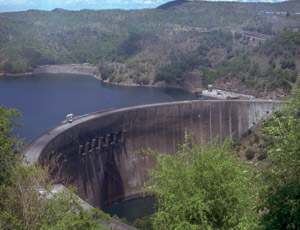China and Zimbabwe have signed a $400-million hydroelectric-power infrastructure deal for the expansion of the 55-year-old Kariba South power station in the 180-billion-cubic meter reservoir-capacity Kariba dam, one of the world’s largest.

“We have signed an agreement with China’s Sinohydro Corp. for the expansion of Kariba by an additional two 150-MW units,” Noah Gwariro, managing director of the Zimbabwe Power Co., said in Harare in early June. The upgrade to the plant’s six existing turbines involves installing replacement runners and modifying other turbine hydraulic components to improve efficiency and capacity, as well as the addition of two new turbines. The upgrade will add 1300 MW to the plant’s capacity of 750 MW.
At 128 meters tall and 579 m long, the Kariba dam is located in Kariba Gorge on the Zambezi River, straddling the Zambia-Zimbabwe border. There are two hydroelectric-power plants in caverns at either end: the Kariba North Bank in Zambia, originally completed in 1977, and the Kariba South Bank in Zimbabwe, originally completed in 1959.
China’s Export and Import (Exim) bank will provide a $250-million loan toward the total project cost through Sinohydro. The Infrastructure Development Bank of Zimbabwe is expected to raise $150 million. No details are available on the Chinese bank’s loan terms or whether Zimbabwe, which is recovering from its worst economic crisis since its independence in 1980, has committed any funds for the project.
The deal between Zimbabwe and Sinohydro increases Zimbabwe’s relationship with China for infrastructure development to more than $1.3 billion, although many of the agreements are still pending, according to a Reuters dispatch.
Zimbabwe has an installed capacity of 1,680 MW, which includes 1,530 MW from hydro sources and another 150 MW from small thermal plants, compared to the national peak demand of 2,500 MW.
This is the second time Zimbabwe has signed a multimillion deal for the expansion of the Kariba South powerplant, which opened in 1959 after four years of construction at a cost of $480 million. In 2005, the government of President Robert Mugabe entered into a $200-million agreement with Iran’s Farab Co. to expand the powerplant, but the project failed to take off after Zimbabwe confessed the country was broke and could not raise any collateral for a loan.
Zambia, at the other end of the dam, also is undertaking an expansion of its power generation facility in the Kariba Dam in a deal with Sinohydro and the Exim bank, also at a total cost of $400 million. That project, which kicked off in March 2009, involves the addition of two generators with a capacity of 360 MW and will bring the total installed capacity at the Zambian plant to 1,080 MW. However, a fire at the site last September is expected to delay commissioning of one of the turbines by about a year, until March 2011.
China is taking the lead in Africa’s dam construction segment, with several countries signing multimillion deal contracts with Sinohydro. It is currently involved in at least 210 projects in at least 48 countries worldwide, according to International Rivers, a non-profit, non-governmental, environmental and human rights organization.
In April, China extended a $700-million loan to the central African nation of Congo for the construction of the country’s biggest water hydroelectric dam, in the Sangha region. Sinohydro is already the construction contractor for the project, raising the profile of the Chinese company that is associated with at least eight other hydropower development projects in Africa.
Aside from the Kariba projects, other Chinese dam investments in sub-Saharan Africa include Bui, in Ghana; Dikgatlhong, in Botswana; Grand Poubara, in Gabon; Imboulou, in Congo-Brazzaville; Merowe, in Sudan; Tekeze, in Ethiopia, and Zungeru, in Nigeria.



Post a comment to this article
Report Abusive Comment